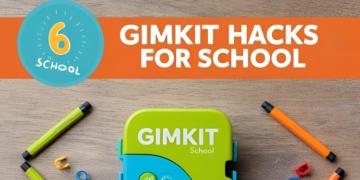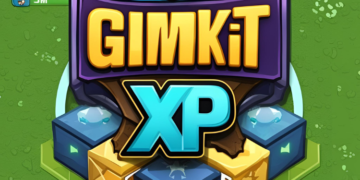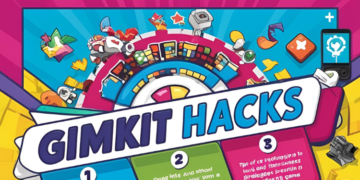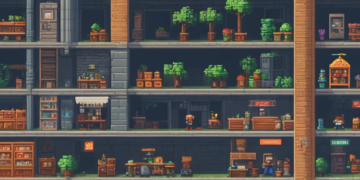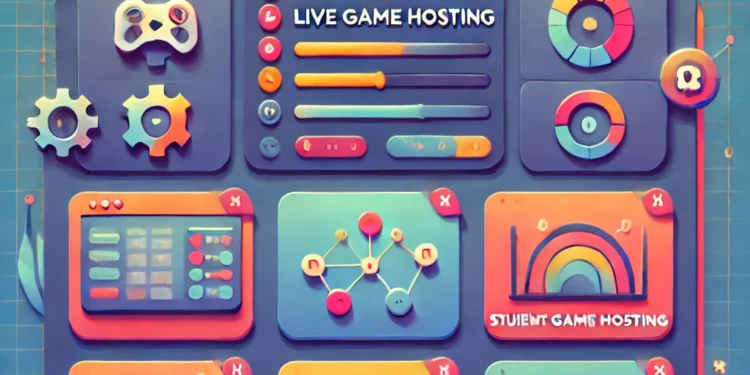What is the Gimkit dashboard?
Gimkit dashboard is the main screen from where you control the entire Gimkit. Whether you want to create a quiz, run a game or see the students’ report – everything happens from here.
It is a kind of teacher’s control room.

What is there in the Dashboard?
- Your Kits – All the quizzes (kits) created by you are visible here. You can edit or reuse them.
- Classes – You can add your class and manage the details of each student.
- Assignments – You can give the quiz to the students as an assignment, which they can solve on their own time.
- Reports – How many correct answers were given by the students, who got how many points – everything is visible here.
- Live Games – If you want to run a quiz game live, then its entire setting is done from here.
Why is Gimkit Dashboard necessary?
Because from here you operate the entire system. It helps you save time, gives you an opportunity to understand students’ performance and makes the entire teaching process easy and fun.
Who Uses the Gimkit Dashboard?

How to Access the Dashboard
The Gimkit dashboard can be used by anyone who uses Gimkit for studying or gaming. But it is mostly used by two main people: Teachers and Students. Let’s understand the roles of both of them in simple language.
-
Teachers – the real users of the Dashboard
The Gimkit dashboard is the most useful tool for teachers. It becomes a kind of teaching assistant for them, from where they can control the entire class.
Teachers use the dashboard to:
- Create new quizzes (kits)
- Edit or reuse old quizzes
- Assign assignments to students
- Start and manage live games
- View student reports and scores
- Organize and track class
In short, the dashboard is a teacher’s complete toolkit — to help make learning fun and organized.
-
Students – Indirect Users
Students also participate in Gimkit, but they rarely use the dashboard directly. Yes, in some cases when they are given assignments or quizzes, they also see sections, such as:
- Quizzes assigned to them
- Their own scores and progress
- Sometimes their class activity
Although the main control is always with the teachers, students also get to see their share of things.
Dashboard Layout & Navigation
When you open the Gimkit dashboard for the first time, everything may seem a bit new at first. But actually its layout is very clean and user-friendly. Everything is so well organized here that you understand it in a few minutes.

Let’s understand it step-by-step:
-
Top Navigation Bar – The top line
There is a navigation bar at the top of the dashboard, which you see on every page. It has some important options:
Home (Dashboard icon) – From here you can return to your main dashboard.
Kits – This is where all your quizzes (kits) are.
Classes – Where you create and manage your classes.
Assignments – From here you can send quizzes to students as assignments.
Reports – To see detailed performance reports after quizzes.
Discover – From where you can also explore quizzes created by other people.
-
Main Dashboard Area –
This is the most important part. When you log in, this is the first thing you see.
Here you see:
Recent Activity – Which quizzes did you create or use.
Quick Access Buttons – Creating a new kit, starting a live game, giving assignments – all these are shortcut buttons.
Class Overview – If you have created a class, then all the information related to that class is found here.
-
Side Menu –
In some layouts, you may also find a side menu bar on the left-side. It also contains quick links to your different sections, which makes navigation even easier.
-
Navigation Experience –
The Gimkit dashboard is designed in such a way that everything is found in 2-3 clicks. The navigation is very smooth even for a new user. It does not take much time to find any option.
- Icons and names are written very clearly.
- As soon as you open each section, you see a simple layout, which does not cause confusion.
- If you use it once, then next time you can use everything easily without thinking.
How to Managing & Hosting Games in Gimkit
Hosting games in Gimkit is a very easy and fun process. First of all, you have to choose a quiz (called Kit) created by you. After clicking on Kit, the option of “Host Game” appears, from which you can start a new game session.
After this, you are asked what kind of game mode you want to choose. There are many different modes in Gimkit like Classic, Team Mode, Trust No One, and other creative modes. You can choose any mode according to your need.
Once you choose the mode, after that you have to do some settings of the game. Like, how long the game will run, how much target cash will be, whether power-ups will be on or not, and whether students can join in the middle of the game or not. You can customize all these settings.
After doing the settings, Gimkit gives a join code or link, which you share with your students. With the help of this gimkit code, students can join the game from their mobile or laptop.
When the game starts, you as a teacher can monitor the entire game live. You can see which student is earning how many points, who has given how many correct answers, and who is leading. A live leaderboard is also visible which clearly shows the performance status.
During the game, if needed, you can pause the game or even stop it immediately. You can also change the settings if you want.
After the game is over, Gimkit gives you a complete detailed report. It shows which student answered what, which questions were most incorrect, and a summary of the entire game.
In this way, hosting and managing games in Gimkit is not only easy, but it also makes the learning of students fun. It not only makes it easier for teachers to teach, but they also get to know the understanding of the children well.
Assignments & Homework Mode
Gimkit not only has live games, but if teachers want, they can also give quizzes to students through Assignments or Homework Mode. Its biggest advantage is that students can solve it at their own time, at their convenience.
Assignments is a way through which you can continue learning even without running a live game.
Step 1: First of all, you have to choose any of your Kit (quiz) which you want to convert into an assignment.
After this, after clicking on that Kit, the option of “Assign Homework” or “Assign as Assignment” appears.
Step 2: From here you can completely customize when the assignment will start and by when the students have to complete it.
You can also set a time limit in it, or if you want, you can give it without a time limit.
In Assignments, students also get the same gaming style as in live games, but the only difference is that no teacher hosts it, nor is there a real-time competition.
In this mode, students play the quiz individually and also learn.
They have the option to pause the game or complete it on their own time so this mode is very beneficial for flexible learning.
When the assignment is over or a student completes it, the teacher receives a detailed report similar to the one received after live games.
The teacher can see who got how many questions right, which student faced difficulty in which topic, and who needs improvement.
The biggest advantage of this mode is that you give students the opportunity for self-paced learning , that is each child can learn at his own pace.
This is especially useful when a student is absent or it is not possible to run the game simultaneously in the entire class.
Reports & Insights: Tracking Student Performance
The most powerful feature of Gimkit is not just the games or quizzes, but the detailed reports and insights that follow. This is what gives a teacher the true data about what their students have learned and where they fell short. In fact, reports are a kind of learning mirror of your class, in which everything is clearly visible.

-
What are reports and why are they important?
When a quiz or game ends, whether it is a live game or in assignment mode, Gimkit automatically prepares a detailed report.
This report contains complete information about the performance of each student.
- This report tells teachers –
- Which student is performing well
- Who got which questions wrong
- Which topics are students facing difficulty in
- Which child needs extra practice
That is, not just scores but deep insights are available.
-
What is visible in the reports?
Gimkit’s reports are very easy and visual, which makes it very easy to understand and take decisions. It includes:
Individual Student Performance: Name of each student, number of correct and incorrect answers, and total virtual cash earned.
Question-wise Analysis: How many children made mistakes on which question, and which question was the easiest or the trickiest.
Overall Class Summary: How much did the whole class score overall and how much accuracy was there.
Time Analysis: Who took how much time, who is answering quickly, and who is answering after thinking.
Strength & Weakness Areas: The report also shows in which chapters or concepts the students are strong and where they need more practice.
-
How to Access Reports?
When the game ends, there is a section named “Reports” in your dashboard.
From here you can easily download the student’s result in PDF format.
-
What is the benefit of reports?
The teacher understands to what extent his teaching strategy has been effective.
- Low-performing students can be identified quickly.
- It becomes easy to plan targeted revision.
- Improvement steps can be taken by quickly understanding the weak areas of the class.
- Students also get their feedback, which helps them in self-improvement.
-
Insights –
Gimkit’s reports do not just tell the marks, they give you deep insights.
That is, you do not just see “who passed” – but you can understand “why a child remained weak.” This is what makes Gimkit different from other platforms.
Kit Library & Content Creation
The most special and useful place in Gimkit is the Kit Library. This is where the study begins and the content is created from here.
Kit means – a quiz or a set of questions, which the teacher can create himself or can also use quizzes created by others.
Now let’s understand step-by-step how this system works.
-
Kit Library – where all your content is
When you login to Gimkit, a section appears – “Kit Library”.
This is like your personal digital shelf, where all the quizzes (kits) created by you are saved.
Here you:
- Can see your old quizzes
- Can create new quizzes
- Can also access kits shared by other teachers
- Can also edit or duplicate any of your quizzes
All the content in this library appears in a neat and organized manner, which makes it easy to find any kit.
-
Content Creation –
Creating a quiz in Gimkit is very easy. When you click on “Create Kit”, a simple form opens in which you have to fill some basic things:
- Kit Name (Title)
- Language (in which language the quiz will be)
- Subject (Maths, Science, English etc.)
- Cover Image (if you want, you can add a picture)
- After this you can start adding questions inside the quiz.
-
How to add questions?
Adding questions is very simple.
- You write a question in each question and then give multiple choice answers for it.
- There is also an option to choose the correct answer, so that students can know right and wrong in the game.
- If you want, you can also add images or math equations to the question – which makes the content even more engaging.
- In Gimkit, you can type questions manually, or there is also an option to import – like importing questions from Google Sheets.
-
Discover Section –
If you don’t have time to create content yourself, you can go to the “Discover” section, where you will find thousands of ready-made kits created by teachers around the world.
You can also customize them by adding them to your library.
-
Reusing Content Over and Over
Once you have created a quiz, you can use it multiple times – whether in a live game, assignments, or homework.
You can change some questions each time or create a new one by duplicating the old quiz.
FAQ About Gimkit Dashboard
Do I need an account to use the dashboard?
Yes, you need to create an account to use Gimkit’s dashboard. Without an account, you cannot create any quizzes (kits), host live games, or track students’ progress. Creating an account keeps your data secure and allows you to take full advantage of all the tools and features. Therefore, an account is mandatory to fully use Gimkit’s dashboard.
Can I delete or edit past games?
Yes, you can delete or edit your previous games in Gimkit, but it depends on which mode you used and how the game is saved. If you have hosted a game, you can view its reports and delete it if needed. However, it is not possible to edit the game’s report. But if you have created a kit, you can make changes to it. That is, the kit is editable, not the report.
How do I reset my password?
If you want to reset your password in Gimkit, it is very easy. First of all go to the login page of Gimkit and click on the “Forgot Password?” option there. After this you have to enter your registered email ID. Gimkit will send a password reset link to that email. You can set a new password by clicking on that link. Keep in mind that the new password should be safe and memorable. If you do not get the email, then definitely check the Spam or Promotions folder.
Can students track their own progress?
Yes, students can track their own progress in Gimkit. When they participate in a game, they are shown a report of their performance after the game is over. In this, they get to know how many questions they got right, where they went wrong and how many points they earned. If the teacher has kept the reports active, then the students can also view their report later. This helps them know their strengths and weaknesses and they can prepare better.

